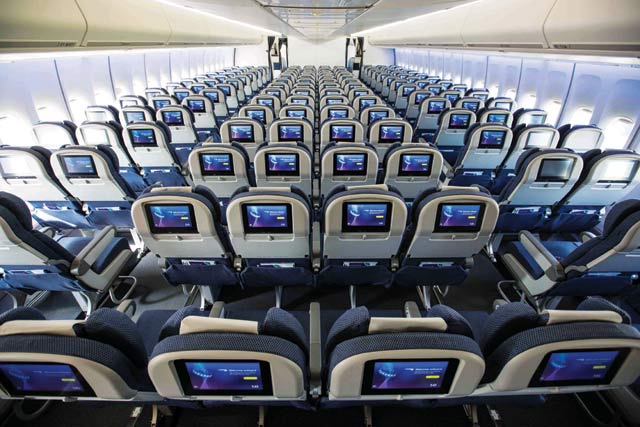In-flight entertainment and connectivity systems are getting a generational make-over. The days of fixed-configuration, hardware-driven systems with almost immediate obsolescence problems appear to be numbered. The future belongs to “the platform”.
Industry-leader Panasonic Avionics on 4 April rolled out its version of the platform-based future IFEC suite branded as Next, promising to deliver a portfolio of customisable applications for both narrowbody and widebody aircraft, starting with the 2020 debut of the Boeing 777X.
“It’s really changing the whole business approach,” says Jon Norris, senior director of corporate sales and marketing for Panasonic.
Get all the coverage from Aircraft Interiors Expo on our dedicated landing page
“It’s not baking in the same business model and saying: ‘That’s what you order, and that’s what you get,’” he adds. “It’s allowing airlines to try different things, and see what works, see what resonates, see what doesn’t.”

Panasonic
The modular and scalable platform approach to IFEC appears to be resonating across the industry. The Panasonics Avionics announcement follows a similar one by Thales Avionics at the APEX Expo in October 2016, which revealed a still-unbranded “platform” concept planned to debut with the entry-into-service of the Airbus A350-1000 in 2018.
New terminology
In borrowing the “platform” terminology from consumer-facing media services, such as Facebook, the IFEC industry is pushing into new territory. The term “platform” itself is deliberately ambiguous, suggesting the industry is moving away from products based on specific combinations of hardware and software-based applications for specific configuration in a single category of aircraft, such as a narrowbody or a widebody.
“I think for us, for the industry, the big change with this kind of ecosystem approach is the flexibility and the agility that we can make changes,” Norris says.
The key for enabling those changes is designing the platform from the beginning to be modular, scalable and reconfigurable. It marks a departure from the classic approach in a heavily regulated aviation industry driven towards strict configuration control. There’s no reason, however, to take the same approach with IFEC. The functions that are subject to safety-of-flight regulations – crew announcements, for instance – can be sequestered in dedicated modules that are subject to more rigorous testing. Other systems can be tailored to suit the needs of particular airlines.
“We can say: ‘These 20 applications were all pre-tested, pre-configured for your system. You can just go and load it,’” says Norris, describing the platform’s new options for customers.
Airlines should also be able to remove it just as easily. IFEC is now designed so that it often requires expensive hardware and software changes any time a single function is added or removed. The platform-based model creates opportunities for airlines to experiment in particular markets flown by a subset of the overall fleet, rather than an all-or-nothing approach.
“The airlines would say, ‘We’re going to try on-demand meals,’ just as an example,” Norris says. “So, ‘We’ll see if that resonates on these long-haul flights on these routes. We’ll pay a fee for that ability to do that. If it does work we’ll expand it across the rest of the fleet.’ The whole industry is not geared up to do that now.”
To enable the platform, Panasonic is developing the hardware that can support the level of modularity expected by airlines in the future. The development anticipates multiple configurations within the same aircraft cabin. As airlines move toward four-class cabins, Next will be able support a certain level of IFEC functionality in business and first, another in premium economy and still others within basic economy.
“There is an amount of technology to put onto the platform – a lot of that is to deal with the different types of media moving across the various domains,” Norris says. “We are seeing airlines with three or four classes of service and you could have a platform which delivers a different type of IFE experience in each class.”
Another way to think about the platform model is to use a different term to describe it. Thales uses the term “content management system” to describe the concept, says Jerry Thomas, Thales director of marketing – business solutions.
Clever stuff
“Our platform, or content management system, is going to have a brain on board the aircraft, it’s going to have a brain on the ground. And those two will work together to manage it all,” says Thomas. “The content is not just movies. It could be notifications, messages from your family. That’s all content.”
In either case, the “brain” is a set of software algorithms that uses information it knows about the passenger – their name, age and gender, for example – to feed advertisements customized to appeal to that demographic. That’s not unlike how Google or Facebook deliver sponsored content to their users, but with one key difference. On the ground, Google and Facebook are constantly referencing the information they have stored about a user in real time. But that will not be practical on an aircraft, so Thales’s platform is designed to feed the latest predictive algorithm to the aircraft on the ground. As the passenger engages the IFEC system, any unexpected reactions will be recorded and fed back into the software model that creates the predictive algorithms, Thomas says.
Source: Flight Daily News



















